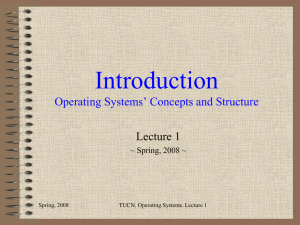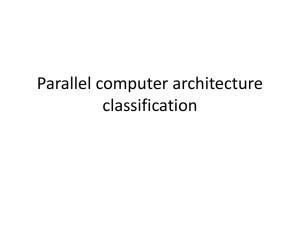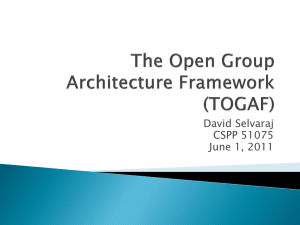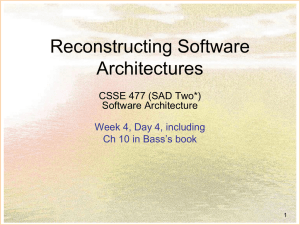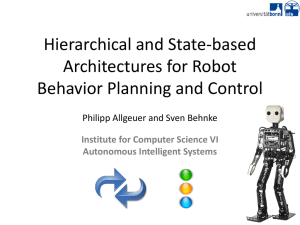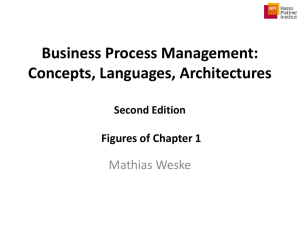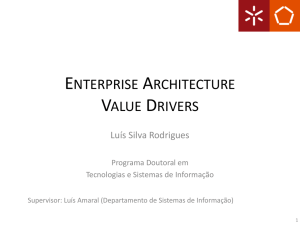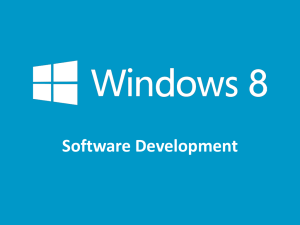Instruction Level Parallelism
advertisement
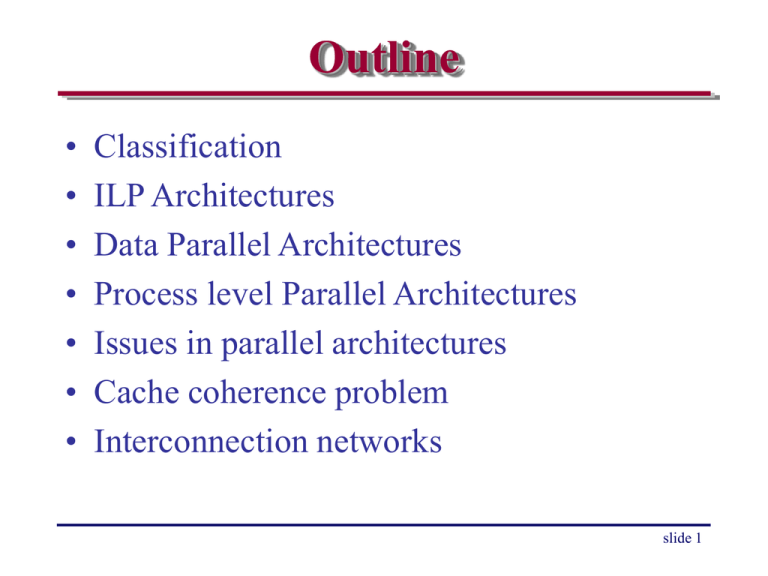
Outline • • • • • • • Classification ILP Architectures Data Parallel Architectures Process level Parallel Architectures Issues in parallel architectures Cache coherence problem Interconnection networks slide 1 Outline • • • • • • • Classification ILP Architectures • Flynn’s [66] Data Parallel Architectures • Feng’s [72] Process level Parallel Architectures • Händler’s [77] • Modern (Sima, Fountain & Kacsuk) Issues in parallel architectures Cache coherence problem Interconnection networks slide 2 Flynn’s Classification Architecture Categories SISD SIMD MISD MIMD slide 3 SISD IS C IS P DS M slide 4 SIMD P IS DS M C P DS slide 5 MISD IS C IS P DS M IS C IS P DS slide 6 MIMD IS C IS P DS M IS C IS P DS slide 7 Feng’s Classification 16K •MPP •PEPE •STARAN 256 bit slice length 64 •IlliacIV •C.mmP 16 •PDP11 •IBM370 •CRAY-1 1 1 16 32 word length 64 slide 8 Händler’s Classification < K x K’ , D x D’ , W x W’ > control data word dash degree of pipelining TI - ASC CDC 6600 C.mmP PEPE Cray-1 <1, 4, 64 x 8> <1, 1 x 10, 60> x <10, 1, 12> (I/O) <16,1,16> + <1x16,1,16> + <1,16,16> <1 x 3, 288, 32> <1, 12 x 8, 64 x (1 ~ 14)> slide 9 Modern Classification Parallel architectures Data-parallel Function-parallel architectures architectures slide 10 Data Parallel Architectures Data-parallel architectures Vector Associative architectures And neural SIMDs Systolic architectures architectures slide 11 Function Parallel Architectures Function-parallel architectures Instr level Parallel Arch (ILPs) Thread level Parallel Arch Pipelined VLIWs Superscalar processors processors Process level Parallel Arch (MIMDs) Distributed Memory MIMD Shared Memory MIMD slide 12 Outline • • • • • • • Classification ILP Architectures Data Parallel Architectures • Pipelining Process level Parallel Architectures • VLIW Issues in parallel architectures • Superscalar Cache coherence problem Interconnection networks slide 13 Pipelining • resource sharing across cycles • all instructions may not take same cycles IF D RF EX/AG M WB • faster throughput with pipelining slide 14 Hazards in Pipelining • Procedural dependencies => Control hazards – conditional and unconditional branches, calls/returns • Data dependencies => Data hazards – RAW (read after write) – WAR (write after read) – WAW (write after write) • Resource conflicts => Structural hazards – use of same resource in different stages slide 15 Pipeline Performance T S stages Frequency of interruptions - b CPI = 1 + (S - 1) * b Time = CPI * T / S slide 16 ILP in VLIW processors Cache/ Fetch memory Unit Single multi-operation instruction FU FU FU Register file multi-operation instruction slide 17 ILP in Superscalar processors Decode Cache/ Fetch memory Unit and issue unit Multiple instruction FU FU FU Sequential stream of instructions Instruction/control Data FU Register file Funtional Unit slide 18 Why Superscalars are popular ? • Binary code compatibility among scalar & superscalar processors of same family • Same compiler works for all processors (scalars and superscalars) of same family • Assembly programming of VLIWs is tedious • Code density in VLIWs is very poor - Instruction encoding schemes slide 19 Issues in VLIW Architecture FU FU FU Register file •Instruction encoding •Scalability: Access time, area, power consumption sharply increase with number of register ports slide 20 Tasks of superscalar processing Parallel Superscalar Parallel Preserving the decoding instruction instruction sequential issue execution consistency of execution Preserving the sequential consistency of exception processing slide 21 Outline • • • • • • • Classification ILP Architectures Data Parallel Architectures Process level Parallel Architectures •SIMD Processors Issues in parallel architectures •Vector Processors •Associative Processors Cache coherence problem •Systolic Arrays Interconnection networks slide 22 Data Parallel Architectures • SIMD Processors – Multiple processing elements driven by a single instruction stream • Vector Processors – Uni-processors with vector instructions • Associative Processors – SIMD like processors with associative memory • Systolic Arrays – Application specific VLSI structures slide 23 Systolic Arrays [H.T. Kung 1978] Simplicity, Regularity, Concurrency, Communication Example : Band matrix multiplication A11 A12 0 0 0 0 B11 B12 0 0 0 0 A 21 A 22 A 23 0 0 0 B 21 B 22 B 23 0 0 0 A31 A32 A33 A34 0 0 B 31 B 32 B 33 B 34 0 0 C 0 A A A A 0 0 B B B B 0 42 43 44 45 42 43 44 45 0 0 A A A A 0 0 B B B B 53 54 55 56 53 54 55 56 0 0 0 A64 A65 A66 0 0 0 B 64 B 65 B 66 slide 24 T=0 B31 A23 A22 A31 B21 A12 A21 A11 B11 B12 Outline • • • • • • • Classification ILP Architectures Data Parallel Architectures Process level Parallel Architectures Issues in parallel architectures •MIMD Processors Cache coherence problem - Shared Memory Interconnection networks Memory - Distributed slide 26 Why Process level Parallel Architectures? Data-parallel architectures Instruction level PAs Built using general purpose processors Function-parallel architectures Thread level PAs Process level PAs (MIMDs) Distributed Memory MIMD Shared Memory MIMD slide 27 MIMD Architectures Design Space • Extent of address space sharing • Location of memory modules • Uniformity of memory access slide 28 Outline • • • • • • • Classification ILP Architectures •User’s perspective Data Parallel Architectures •Architect’s perspective Process level Parallel Architectures Issues in parallel architectures Cache coherence problem Interconnection networks slide 29 Issues from user’s perspective • Specification / Program design – explicit parallelism or – implicit parallelism + parallelizing compiler • Partitioning / mapping to processors • Scheduling / mapping to time instants – static or dynamic • Communication and Synchronization slide 30 Parallel programming models Concurrent control flow Functional or logic program Vector/array operations Concurrent tasks/processes/threads/objects With shared variables or message passing Relationship between programming model and architecture ? slide 31 Issues from architect’s perspective • Coherence problem in shared memory with caches • Efficient interconnection networks slide 32 Outline • • • • • • • Classification ILP Architectures •Coherence Protocols Bus or directory based Data Parallel -Architectures Invalidate or update Process level -Parallel Architectures - Definition of states Issues in parallel architectures Cache coherence problem Interconnection networks slide 33 Cache Coherence Problem Multiple copies of data may exist Problem of cache coherence Options for coherence protocols • What action is taken? – Invalidate or Update • Which processors/caches communicate? – Snoopy (broadcast) or directory based • Status of each block? slide 34 Outline • • • • • • • Classification ILP Architectures Data Parallel Architectures Process level Parallel Architectures •Switching and control Issues in parallel architectures •Topology Cache coherence problem Interconnection networks slide 35 Interconnection Networks • Architectural Variations: – Topology – Direct or Indirect (through switches) – Static (fixed connections) or Dynamic (connections established as required) – Routing type store and forward/worm hole) • Efficiency: – Delay – Bandwidth – Cost slide 36 Books • D. Sima, T. Fountain, P. Kacsuk, "Advanced Computer Architectures : A Design Space Approach", Addison Wesley, 1997. • M.J. Flynn, "Computer Architecture : Pipelined and Parallel Processor Design", Narosa Publishing House/ Jones and Bartlett, 1996. • D.A. Patterson, J.L. Hennessy, "Computer Architecture : A Quantitative Approach", Morgan Kaufmann Publishers, 2002. • K. Hwang, "Advanced Computer Architecture : Parallelism, Scalability, Programmability", McGraw Hill, 1993. • H.G. Cragon, "Memory Systems and Pipelined Processors", Narosa Publishing House/ Jones and Bartlett, 1998. • D.E. Culler, J.P Singh and Anoop Gupta, "Parallel Computer Architecture, A Hardware/Software Approach", Harcourt Asia / Morgan Kaufmann Publishers, 2000. slide 37

